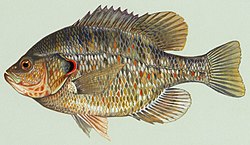Redear Sunfish
| Redear sunfish Temporal range: Middle Miocene to Recent |
|
|---|---|
 |
|
| Scientific classification | |
| Kingdom: | Animalia |
| Phylum: | Chordata |
| Class: | Actinopterygii |
| Order: | Perciformes |
| Family: | Centrarchidae |
| Genus: | Lepomis |
| Species: | L. microlophus |
| Binomial name | |
|
Lepomis microlophus (Günther, 1859) |
|
The redear sunfish (Lepomis microlophus, also known as the shellcracker, Georgia bream, cherry gill, chinquapin, improved bream, rouge ear sunfish and sun perch) is freshwater fish native to the southeastern United States. Since it is a popular sport fish, it has been introduced to bodies of water all over North America. It is known for its diet of mollusks and snails.
The redear sunfish generally resembles the bluegill except for coloration and somewhat larger size. The redear sunfish also has faint vertical bars traveling downwards from its dorsal. It is dark-colored dorsally and yellow-green ventrally. The male has a cherry-red edge on its operculum; females have orange coloration in this area. The adult fish are between 20 and 24 cm (7.9 and 9.4 in) in length. Max length is 43.2 cm (17.0 in), compared to a maximum of about 40 cm (16 in) for the bluegill. Lepomis microlophus averages at a size of about 0.45 kg (0.99 lb), also larger than the average bluegill.
Redear sunfish are native to North Carolina and Florida, west to south Illinois and south Missouri, and south to the Rio Grande drainage in Texas. However, this fish has also been widely introduced to other locations in the United States outside of its native range. In the wild, the redear sunfish inhabits warm, quiet waters of lakes, ponds, streams, and reservoirs. They prefer to be near logs and vegetation, and tend to congregate in groups around these features. This sunfish is also located in many marsh wetlands of freshwater.
The favorite food of this species is snails. These fish meander along lakebeds, seeking and cracking open snails and other shelled creatures. Redears have thick pharyngeal teeth (hard, movable plates in its throat) which allow it to crunch exoskeletons. It is even capable of opening small clams. The specialization of this species for the deep-water, mollusk-feeding niche allows it to be introduced to lakes without the risk of competition with fish that prefer shallower water or surface-feeding. In recent years, the stocking of redear has found new allies due to the fish's ability to eat quagga mussels, a prominent invasive species in many freshwater drainages.
...
Wikipedia

